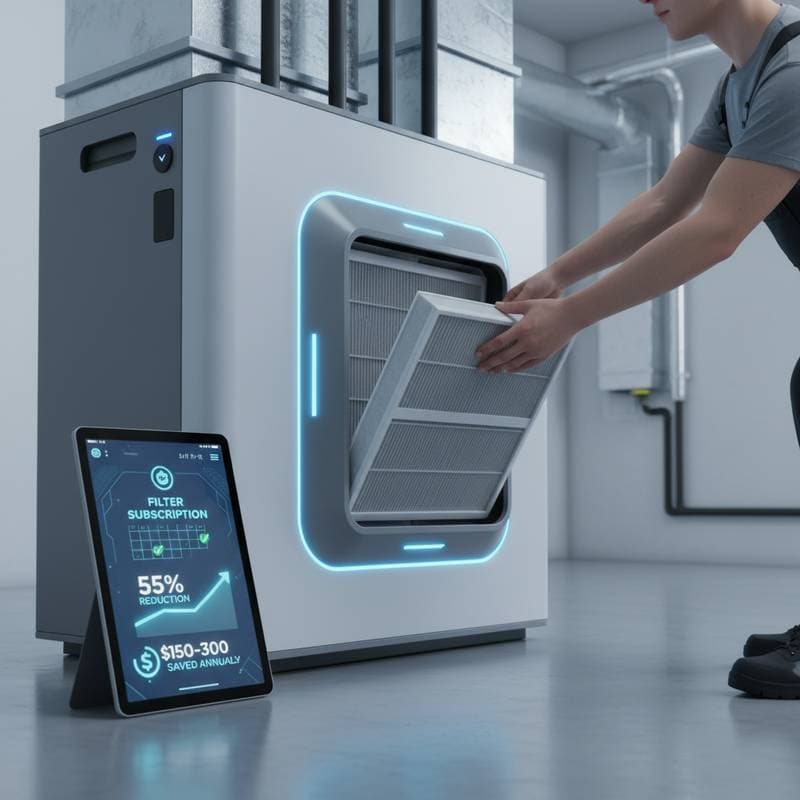DIY Filter Changes Reduce HVAC Service Calls by 55 Percent in 2025
Homeowners who perform their own HVAC filter replacements achieve a significant reduction in service calls, often by more than half. Clean filters maintain consistent airflow, which minimizes strain on the system and helps prevent issues such as frozen coils or overheating components. This straightforward maintenance practice extends the lifespan of the unit, decreases energy consumption, and limits the need for urgent repairs. The following sections outline the mechanisms behind these benefits, guidance on filter selection and replacement, and strategies to simplify the process through subscriptions or reminders.
| Item | Key Benefit |
|---|---|
| Average Reduction in Service Calls | 55 percent fewer repair visits |
| Typical Filter Replacement Cost | $10 to $40 per filter |
| Recommended Replacement Frequency | Every 1 to 3 months |
| Average Annual Savings | $150 to $300 on service calls |
| Added System Longevity | Up to 3 additional years of operation |
Factors Influencing Filter Effectiveness and System Durability
The performance of an HVAC filter extends beyond replacement frequency. Multiple elements determine how well air circulates through the system and how long the equipment remains reliable.
Filter Quality and MERV Rating
The MERV rating, or Minimum Efficiency Reporting Value, quantifies a filter's ability to trap airborne particles, with values from 1 to 16.
- MERV 1 to 4: Provides essential capture of large particles, such as dust and lint, suitable for basic residential needs.
- MERV 5 to 8: Offers effective filtration for homes with pets or individuals experiencing moderate allergies.
- MERV 9 to 12: Delivers advanced protection by trapping smaller allergens like pollen and mold spores.
- MERV 13 to 16: Achieves hospital-level purification, removing fine dust, smoke, and bacteria.
Higher MERV ratings improve indoor air quality, yet they may impede airflow in systems not equipped to handle increased resistance. Consult the manufacturer's guidelines for your HVAC unit before selecting a higher-rated filter to avoid potential efficiency losses.
Household Environment
Environments with pets, tobacco use, or high dust levels accelerate filter clogging. Residences involving frequent cooking or frequent opening of windows also demand more regular attention. The primary objective remains unobstructed airflow. Accumulated debris forces the blower motor to operate at higher intensities, which diminishes overall efficiency and accelerates component wear.
HVAC Usage Patterns
Units that operate continuously, particularly in regions with extreme temperatures, necessitate closer monitoring. Systems used seasonally might allow for slightly longer intervals between changes, though a monthly visual check proves advisable. Such inspections reveal early signs of buildup, enabling timely intervention.
Installation Quality
Improper filter placement permits unfiltered air to circumvent the mechanism, resulting in accelerated dirt accumulation on coils and other internal parts. Secure the filter firmly within its designated slot, ensuring the directional arrows align with the airflow path toward the blower. This step guarantees comprehensive protection for the system.
Indicators That Signal the Need for Filter Replacement
Prompt recognition of replacement cues safeguards the HVAC system from excessive stress. Consider these typical warning signs:
- Diminished airflow emerging from vents
- Unexpected increases in energy bills despite stable usage patterns
- Accumulation of dust on air registers or household surfaces
- Emission of musty or dusty scents from the ventilation system
- Extended operational cycles or instances of overheating
- Apparent soiling or darkening on the filter's surface
Address these symptoms by replacing the filter without delay. Failure to do so risks complications including coil freezing, irregular cycling, and potential blower motor malfunction.
Step-by-Step Guide to DIY Filter Replacement
Performing a filter change requires minimal tools and time, typically under 10 minutes. Follow these steps to ensure proper execution:
- Locate the filter compartment, usually accessible via a panel near the return air duct or furnace.
- Turn off the HVAC system at the thermostat and power source for safety.
- Remove the old filter by sliding it out and note the airflow direction indicated by arrows.
- Inspect the new filter for compatibility in size and rating, then insert it with arrows pointing toward the blower.
- Secure the panel and restore power, followed by a test run to verify airflow.
Select filters matching your system's dimensions, available at hardware stores or online. For convenience, consider bulk purchases or delivery subscriptions that align with your replacement schedule.
Savings on HVAC Labor Through Proactive Filter Care
Clogged filters frequently trigger failures that incur costs for both labor and replacement parts. HVAC technicians charge between $75 and $150 per hour, varying by region and repair complexity.
Neglected filters commonly provoke these issues:
- Overheating of motors from constrained airflow
- Freezing of evaporator coils due to insufficient circulation
- Contamination of ducts and coils, necessitating specialized cleaning
- Overall efficiency decline, which elevates energy demands
Consistent filter maintenance circumvents most of these scenarios. Homeowners often eliminate one to two annual service visits, yielding substantial financial relief and prolonging the unit's operational years.
Establishing a Maintenance Routine for Long-Term Benefits
Incorporate filter replacements into a broader preventive strategy to optimize HVAC performance. Use calendar alerts or apps to schedule checks every 30 to 90 days, depending on your environment. Track each change to monitor patterns and adjust as needed.
This practice not only curbs repair expenses but also enhances indoor comfort and air purity. Should airflow issues persist or unusual sounds arise, engage a certified technician for a thorough evaluation. Consistent care ensures reliable operation year-round, providing peace of mind and tangible savings.





